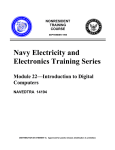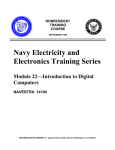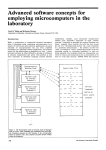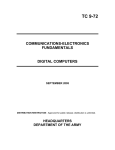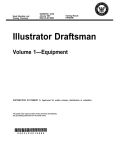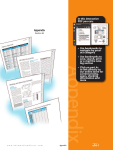Download INTRODUCTION TO PROGRAMMING
Transcript
INTRODUCTION TO PROGRAMMING Problem Solving Concepts, Flowcharting, and Programming Languages It is the intent of this manual to provide an introduction to computer programming, and to the programming language, BASIC (Beginners All-Purpose Symbolic Instruction Code). BASIC is a popular programming language, especially for new programmers and casual computer users. Its conversational nature makes communicating with computers natural, simple, and straightforward. Its use of near English words and mathematical expressions gives the coding a familiar appearance. Also, its original design, to teach the casual user how to program, makes it a good language to learn first. For those of you with computer operations experience, this course is intended to provide a transition from operations into programming. It will introduce concepts of programming that apply to other languages as well as BASIC. For those of you with programming experience, it will provide a review of programming concepts and introduce the capabilities of BASIC and its syntax. For those not in data processing, who have a computer available, it will pro-vide an introduction to a programming language available on most computers. When you complete the course, you should understand the capabilities and syntax of the BASIC language and be able to write a program. OVERVIEW OF PROGRAMMING Before learning to program in the language, BASIC, it is helpful to establish some context for the productive part of the entire programming effort. This context comprises the understanding and agreement that there are four fundamental and discrete steps involved in solving a problem on a computer. The four steps are: 1. State, analyze, and define the problem. 2. Develop the program logic and prepare a program flowchart or decision table. 3. Code the program, prepare the code in machine readable form, prepare test data, and perform debug and test runs. 4. Complete the documentation and prepare operator procedures for implementation and production. Figure 1-1 depicts the evolution of a program. Programming can be complicated, and advance preparation is required before you can actually start to write or code the program. The first two steps, problem understanding/definition and flowcharting, fall into the advance planning phase of programming. It is important at this point to develop Figure 1-1. Evolution of a Program. correct habits and procedures, since this will prevent later difficulties in pro-gram preparation. Whether you are working with a systems analyst, a customer, or solving a problem of your own, it is extremely important that you have a thorough understanding of the problem. Every aspect of the problem must be defined: What is the problem? What information (or data) is needed? Where and how will the information be obtained? What is the desired output? Starting with only a portion of the information, or an incomplete definition, will result in having to constantly alter what has been done to accommodate the additional facts as they become available. It is easier and more efficient to begin programming after all of the necessary information is understood. Once you have a thorough understanding of the problem, the next step is flowcharting. FLOWCHARTING Flowcharting is one method of pictorially representing a procedural (step-by- step) solution to a problem before you actually start to write the computer instructions required to produce the desired results. Flowcharts use different shaped symbols connected by one-way arrows to represent operations, data, flow, equipment, and so forth. There are two types of flowcharts, system (data) flowcharts and programming flowcharts. A system (data) flowchart defines the major phases of the processing, as well as the various data media used. It shows the relationship of numerous jobs that makeup an entire system. In the system (data) flowchart, an entire program run or phase is always represented by a single processing symbol, together with the input/output symbols showing the path of data through a problem solution. For example: System Flowchart The second type of flowchart and the one we’ll use in this manual is the programming flowchart. It is constructed by the programmer to represent the sequence of operations the computer is to perform to solve a specific problem. It graphically describes what is to take place in the program. It displays specific operations and decisions, and their sequence within the pro-gram. For example: Programming Flowchart Tools of Flowcharting Flowcharting has been defined, and two different types of flowcharts discussed. We will now take a look at the tools used in flowcharting. These tools are the fundamental symbols, graphic symbols, flowcharting template, and the flowcharting worksheet. FUNDAMENTAL SYMBOLS. To construct a flowchart, it is first necessary to know the symbols and their related meanings. They are standard for the military, as directed by Department of the Navy Automated Data Systems Documentation Standards, SECNAVINST 5233.1 (Series). Symbols are used to represent functions. These fundamental functions are processing, decision, input/output, terminal, flow lines and connector symbol. All flowcharts may be initially constructed using only these fundamental symbols as a rough outline to work from. Each symbol corresponds to one of the functions of a computer and specifies the instruction(s) to be performed by the computer. The contents of these symbols are called statements. Samples of these fundamental symbols, definitions, examples, and explanations of their uses are shown in figure 1-2. GRAPHIC SYMBOLS. Within a flowchart, graphic symbols are used to specify arithmetic operations and relational conditions. The following are commonly-used arithmetic and relational symbols. FLOWCHARTING TEMPLATE. To aid in drawing the flowcharting symbols, you may use a flowcharting template. Figure 1-3 shows a template containing the standard symbol cutouts. A template is usually made of plastic with the symbols cut out to allow tracing the outline. PROCESS SYMBOL is used to represent general processing functions not represented by other symbols. It depicts the process of operations resulting in a change of value, form, or location of information. INPUT/OUTPUT SYMBOL is used to represent any function of an I/O device. Making information available for processing is an Input function; recording processed information is an Output function. DECISION SYMBOL is used to depict a point in a program at which a branch to one of two or more alternate paths is possible. TERMINAL, INTERRUPT SYMBOL start, stop, halt, delay, or interrupt. CONNECTOR SYMBOL represents a junction in a line of flow to another part of the flowchart. A common identifier, such as an alphabetic character, number, or mnemonic label, is placed within the exit and its associated entry. FLOWLINE SYMBOL is used to represent flow direction by lines drawn between symbols. Normal direction of flow is left to right and top to bottom. If the direction of flow is other than normal, arrowheads are required at the point of entry. Divide I by 12 assign value to R. Enter these values through the terminal, store in locations B, D, I. If A is NOT equal to B, take NO branch. If A is equal to B, take YES branch. START/STOP flow chart at this point. This represents the EXIT point and the ENTRY point in a flowchart. Initial processing is shown here. If the NO branch is taken, the processing block is performed again. If the YES branch is taken, the INPUT/OUTPUT operation is performed. Figure 1-3. Flowchart Template. FLOWCHART WORKSHEET. The Flowchart Worksheet is a means of standardizing documentation. It provides space for drawing programming flowcharts and contains an area for identification of the job, including application, procedure, date and page numbers (fig. 1-4). You may find it helpful when you develop flowcharts. If you don’t have this form available, a plain piece of paper will do. Constructing a Flowchart There is no "best way" to construct a flowchart. There is no way to standardize problem solution. Flowcharting and programming techniques are often unique and conform to the individual’s own methods or direction of problem solution. This manual will show an example of developing a programming flowchart. It is not the intent to say this is the best way; rather, it is one way to do it. By following this text example you should grasp the idea of solving problems through flowchart construction. As you gain experience and familiarity with a computer system, these ideas will serve as a foundation. In order to develop a flowchart, you must first know what problem you are to solve. It is then your job to study the problem definition and develop a flowchart to show the logic, steps, and sequence of steps the computer is to execute in order to solve the problem. As an example, suppose you have taken a short-term second mortgage on a new home, and you want to determine what your real costs will be: the amount of interest; the amount to be applied to principal; and the final payment at the end of the three year loan period. Figure 1-4. Flowchart Worksheet. The first step is to be sure you understand the problem completely. What are the inputs and the outputs and what steps are needed to answer the questions? Even when you are specifying a problem of your own, you’ll find we don’t usually think in small detailed sequential steps. But, that is exactly how a computer operates; one step after another in a specified order. Therefore, it is necessary for you to think the problem solution through step-by- step. You might clarify the problem as shown by the Problem Definition in figure 1-5. After you have this level of narrative problem definition, you are ready to develop a flowchart showing the logic, steps, and sequence of steps you want the computer to execute in order to solve the problem. A programming flowchart of this problem is also shown in figure 1-5. You now have a plan of what you want the computer to do. The next step is to code a program that can be translated by a computer into a set of instructions it can execute. This step is called program coding. PROGRAM CODING It is important to remember program coding is not the first step of programming. Too often we have a tendency to start coding too soon. As we discussed earlier, there is a great deal of planning and preparation to be done prior to sitting down to code the computer instructions to solve a problem. For the example amortization problem (fig. 1-5), we have analyzed the specifications in terms of (1) the output desired; (2) the operations and procedures required to produce the output; and (3) the input data needed. In conjunction with this analysis, we have developed a programming flowchart which outlines the procedures for taking the input data and processing it into usable output. You are now ready to code the instructions that will control the computer during processing. This requires that you know a programming language. Before getting into the specific programming language called BASIC, it may be helpful to have a greater understanding of programming languages in general. All programming languages are composed of instructions that enable the computer to process a particular application, or perform a particular function. Instructions The instruction is the fundamental element in program preparation. Like a sentence, an instruction consists of a subject and a predicate. However, the subject is usually not specifically mentioned; rather it is some implied part of the computer system directed to execute the command that is given. For example, the chief tells a sailor to "dump the trash." The sailor will interpret this instruction correctly even though the subject "you" is omitted. Similarly, if the computer is told to, "ADD 1234," the control unit may interpret this to mean that the arithmetic-logic unit is to add the contents of address 1234 to the contents of the accumulator. In addition to an implied subject, every computer instruction has an explicit predicate consisting of at least two parts. The first part is referred to as the command, or operation; it answers the question "what?. " It tells the PROBLEM DEFINITION MORTGAGE AMORTIZATION This program is to determine the monthly amount of interest (A) and amount applied to the principal (P) of the mortgage giving the balance (B) at the end of a thirty-six month period. INPUT: The monthly payment is to be entered as variable D, the beginning balance of the mortgage is to be entered as variable B, and the annual interest rate is to be entered as variable I. This input is to be entered into the system via the terminal. OUTPUT: The end result is to be a listing displaying the amount applied to principal and interest and the current loan balance each month, with one final entry showing the final payment on the mortgage. Figure 1-5. Problem Definition and Programming Flowchart. computer what operation it is to perform; i.e., read, print, input. Each machine has a limited number of built-in operations that it is capable of executing. An operation code is used to communicate the programmer’s intent to the computer. The second specific part of the predicate, known as the operand names the object of the operation. In general, the operand answers the question "where?." Operands may indicate the following: 1. The location where data to be processed is found. 2. The location where the result of processing is to be stored. 3. The location where the next instruction to be executed is found. (When this type of operand is not specified, the instructions are executed in sequence.) The number of operands and the structure or format of the instructions vary from one computer to another. However, the operation always comes first in the instruction and is followed by the operand(s). The programmer must prepare instructions according to the format required by the language and the computer to be used. Instruction Set The number of instructions in a computer’s instruction set may range from less than 30 to more than 100. These instructions may be classified into categories such as input/output (I/O), data movement, arithmetic, logic, and transfer of control. Input/output instructions are used to communicate between I/O devices and the central processor. Data movement instructions are used for copying data from one storage location to another and for rearranging and changing of data elements in some prescribed manner. Arithmetic instructions permit addition, subtraction, multiplication, and division. They are common in all digital computers. Logic instructions allow comparison between variables, or between variables and constants. Transfer of control instructions are of two types, conditional or unconditional. Conditional transfer instructions are used to branch or change the sequence of program control, depending on the outcome of the comparison. If the out-come of a comparison is true, control is transferred to a specific statement number; if it proves false, processing continues sequentially through the program. Unconditional transfer instructions are used to change the sequence of program control to a specified program statement regardless of any condition. Programming Languages Programmers must use a language that can be understood by the computer. There are several methods that can achieve humancomputer communication. For example, let us assume the computer only understands French and the programmer speaks English. The question arises: How are we to communicate with the computer? One approach is for the programmer to code the instructions with the help of a translating dictionary prior to giving them to the processor. This would be fine so far as the computer is concerned; however, it would be very awkward for the programmer. Another approach is a compromise between the programmer and computer. The programmer first writes instructions in a code that is easier to relate to English. This code is not the computer’s language; therefore, it does not understand the orders. The programmer solves this problem by giving the computer another program, one that enables it to translate the instruction code into its own language. This translation program, for example, would be equivalent to an English-to- French dictionary, leaving the translating job to be done by the computer. The third and most desirable approach from an individual’s standpoint, is for the computer to accept and interpret instructions written in everyday English terms. Each of these approaches has its place in the evolution of programming languages and is used in computers today. The first approach is known as machine language, the second as symbolic, and the third as procedure-oriented. MACHINE LANGUAGES. With early computers, the programmer had to translate instructions into the machine language form that the computers understood. This language was a string of numbers that represented the instruction code and operand address(es). In addition to remembering dozens of code numbers for the instructions in the computer’s instruction set, the programmer also had to keep track of the storage locations of data and instructions. This process was very time consuming, quite expensive and often resulted in errors. Correcting errors or making modifications to these programs was a very tedious process. SYMBOLIC LANGUAGES. In the early 1950s, mnemonic instruction codes and symbolic addresses were developed. This improved the program preparation process by substituting letter symbols (mnemonic codes) for basic machine language instruction codes. Each computer has mnemonic code, although the symbols vary among the different makes and models of computers. The computer still uses machine language in actual processing, but it translates the symbolic language into machine language equivalent. Symbolic languages have many advantages over machine language coding in that less time is required to write a program, detail is reduced, and fewer errors are made. Errors which are made are easier to find, and programs are easier to modify. PROCEDURE-ORIENTED LANGUAGES. The development of mnemonic techniques and macroinstructions led to the development of procedure-oriented languages. These languages are oriented toward a specific class of processing problems. A class of similar problems is isolated, and a language is developed to process these types of applications. Several languages have been designed to process problems of a scientific-mathematical nature and others that emphasize file processing. The most familiar of these are BASIC and FORTRAN for scientific or mathematical problems, and COBOL for file processing. Programs written in procedure-oriented languages, unlike those in symbolic languages, may be used with a number of different computer makes and models. This feature greatly reduces reprogramming expenses when changing from one computer system to another. Other advantages to procedure-oriented languages are: (1) they are easier to learn than symbolic languages; (2) they require less time to write; (3) they provide better documentation; and (4) they are easier to maintain. However, there are some disadvantages of procedure-oriented languages. They require more space in memory and they process data at a slower rate than symbolic languages. Coding a Program Regardless of the language used, there are strict rules the programmer must adhere to with regard to punctuation and statement structure when coding any program. Using the programming flowchart introduced earlier, we have now added a program coded in BASIC to show the relationship of the flowchart to the actual coded instructions (fig. 1-6). Don’t worry about complete understanding, just look at the instructions with the flowchart to get an idea of what coded instructions look like. You will have to have specific information about the computer you are to use and how the language is implemented on that particular computer. The computer manufacturers provide these specifics in their user’s manual. Get a copy and study it before you begin to code. To you, but they may prevent your program from running. Once coding is completed, the program must be debugged and tested prior to implementation. Debugging Errors caused by faulty logic and coding mistakes are referred to as "bugs." Finding and correcting these mistakes and errors that prevent the program from running and producing correct output is called "debugging." Rarely do complex programs run to completion on the first attempt. Often, time spent debugging and testing equals or exceeds the time spent in program coding. This is particularly true if insufficient time was spent on problem definition and logic development. Some common mistakes which cause program bugs are: mistakes in coding punctuation, incorrect operation codes, transposed characters, keying errors and failure to provide a sequence of instructions (a program path) needed to process certain conditions. To reduce the number of errors, you will want to carefully check the coding sheets before they are turned in for keying. This process is known as "desk-checking" and should include an examination for program completeness. Typical input data should be manually traced through the program processing paths to identify possible errors. In effect, you will be attempting to play the role of the computer. After the program has been desk-checked for accuracy, the program is ready to be assembled or compiled. Assembly and compiler programs prepare your program (source program) to be executed by the computer and they have error diagnostic features which detect certain types of mistakes in your program. These mistakes must be corrected. Even when an error-free pass of the program through the assembly or compiler program is accomplished, this does not mean your program is perfected. However, it usually means the program is ready for testing. Testing Once a program reaches the testing stage, generally, it has proven it will run and produce output. The purpose of testing is to determine that all Figure 1-6. Programming Flowchart and Coded Program. data can reprocessed correctly and that the output is correct. The testing process involves processing input test data that will produce known results. The test data should include: (1) typical data, which will test the commonly used program paths; (2) unusual but valid data, which will test the program paths used to process exceptions; and (3) incorrect, incomplete, or inappropriate data, which will test the program’s error routines. If the pro-gram does not pass these tests, more testing is required. You will have to examine the errors and review the coding to make the coding corrections needed. When the program passes these tests, it is ready for computer implementation. Before computer implementation takes place, documentation must be completed. Documentation Documentation is a continuous process, beginning with the problem definition. Documentation involves collecting, organizing, storing, and other-wise maintaining a complete record of the programs and other documents associated with the data processing system. The Navy has established documentation standards to ensure completeness and uniformity for computer system information between commands and between civilian and Navy organizations. SECNAVINST 5233.1 (Series) establishes minimum documentation requirements. Local minimum documentation requirements are usually established by the head of the data processing department/division. At most commands this function is delegated to the project manager. The key to the minimum amount of documentation required by local commands should be the amount that is required for replacement personnel to understand input, processing, and output for each program or system for which they will be responsible. A documentation package should include: 1. A definition of the problem. Why was the program written? What were the objectives? Who requested the program, and who approved it? These are the types of questions that should be answered. 2. A description of the system. The system environment (hardware, software, and organization) in which the program functions should be described (including systems flowcharts). General systems specifications outlining the scope of the problem, the form and type of input data to be used, and the form and type of output required should be clearly defined. 3. A description of the program. Programming flowcharts, program listings, program controls, test data and test results, storage dumps these and other documents that describe the program and give a historical record of problems and/or changes should be included. 4. Operator instructions. Items that should be included are computer switch settings, loading and unloading procedures, and starting, running, and termination procedures. Implementation After the documentation has been completed, and the user has reviewed and accepted the test output, the project request is submitted to upper management, usually the ADP department head, for production approval. Once upper management has approved the program, it can be put into production. If a program is to replace a program in an existing system, it is generally wise to have a period of parallel processing; that is, the job application is processed both by the old program and by the new program. The purpose of this period is to verify processing accuracy and completeness. Once the program is in production it maybe necessary to make modifications to the program to satisfy changing requirements. This is another important duty of the programmer, and it is not unusual to find programmers spending 25 percent of their time on this program maintenance activity. In some installations, there are programmers who do nothing but maintain production programs. SUMMARY The first step in the solution of any problem involves a fundamental but often overlooked concept a thorough understanding of the problem. The second step in successful problem solving involves creating a flowchart showing the steps required to solve the problem. Flowcharting is a pictorial means of representing a procedural solution to a problem in which different shaped symbols are used to represent operations, data, flow, equipment and so forth. There are two types of flowcharts system (data) and programming. The tools of flowcharting are: (1) fundamental symbols; (2) graphic symbols; (3) flowcharting template; and (4) flowcharting worksheet. The problem definition and flowchart development steps must be done prior to sitting down to code the computer instructions to solve a problem. Regardless of the language used, there are strict rules you must adhere to with regard to punctuation and statement structure when coding a program. Once the program is coded, there are several phases that must be done before it can be put into production. These are desk-checking, debugging, testing, documentation and finally, implementation.

















